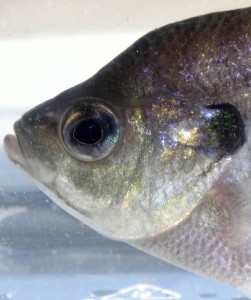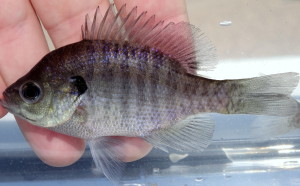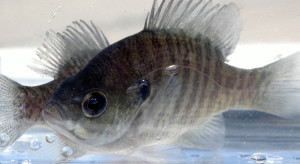Bluegill (Lepomis macrochirus)
Common names: Bluegill, Brim, Bream, Perch




If the largemouth bass is the king of freshwater sportfish in the United States, the humble bluegill is the throne holding it up. Bluegill are the most common forage fish stocked in farm ponds in the south and are the key forage species for largemouth bass. The bluegill has probably accounted for the vast majority of first fish ever caught by most U.S. anglers. Think back to that first glimmering little grey fish dangling from the end of your line under a bobber, and I bet you will come to realize it was a bluegill. These little “panfish” are a prized sportfish themselves as their abundance, savory pan-fried fillets, and bull-dogged pound for pound fighting ability tempt bluegill aficionados across the country.
Range: Bluegill are native to much of the eastern and central U.S. (Mississippi River basin, Atlantic and Gulf Slope drainages). They are now common across the continental U.S. due to widespread stockings and introductions. The coppernose bluegill, L. macrochirus purpurescens (also designated as L. m. mystacalis), is a subspecies native to Florida that is raised and sold for pond stocking in much of the southeast.
Description: An iridescent blue color on the lower portion of both the jaw and gill cover gives the bluegill its common name. The body is slab-like, deep and flattened, and the head is bluntly pointed. The mouth is very small and slants down into the jaw, not reaching quite as far back as the eye. The dorsal (top) fin has a series of 10 (can be 9 to 11) spines in the first half of the fin, followed by a rounded, soft section. The bottom fins (pelvic and anal) also have spines. The pectoral fins are very long and pointed. The short, broad ear flap is a solid dark blue to black, and on fish larger than 2 inches there is a dark splotch at the bottom of the soft dorsal fin. Bluegills have five to nine dark, vertical bands running down their sides. Coloration is variable, and males and females differ in color, especially in the breeding season. Breeding males become a dark bluish-green with darker, vertical bars; the head has bright blue tones and the breast develops a rusty orange color. Females are lighter in color, with faint vertical bars and a white to grayish-white belly. Adults typically reach 6 to 10 inches in length, although greater lengths may be obtained. The male coppernose bluegill has a purplish head (jaw and gill covers) and a copper-colored band across the head above the eyes that is prominent in the breeding season. Trying to identify bluegill from other sunfish species by body coloration alone is unreliable. As with most fish, bluegills take on different colors depending on factors like age, sex, and water clarity.
Biology and Life History: Bluegill generally school in small groups of 5 to 20 fish, although larger congregations do occur. Bluegill are sight-feeders, consuming aquatic vegetation, zooplankton, insect larvae, insects, fish eggs and, occasionally, minnows and small fish, although insects and other invertebrates compose the majority of their diet throughout their life. Bluegills feed primarily under low light conditions at dawn and dusk, but are opportunistic and will feed whenever a meal presents itself. In the spring when water temperature approaches 67ºF, males move shallow in search of suitable spawning habitat. Male bluegill will sweep out a nest in the pond bottom, forming a circular depression 2″ to 6″ deep. Clusters of these nests are found together in shallow water and are called “beds.” Males will typically build nests in colonies, and these colonies can contain 50 or more nests. Spawning sites are usually in shallow sand or gravel, but males will sweep depressions in the clay bottom if suitable habitat is not available. Bluegill start spawning in late spring at around 70 ºF and spawn periodically until early fall, providing a plentiful supply of small forage. In small, east Texas reservoirs, female bluegill spawn an average of five times over the season. Males greet females with a spawning display in which they rapidly and repeatedly swim circles around their nests. Females may deposit eggs in one or more nests, and often more than one female may use the same nest as the most “fit” males are usually selected by more than one female. Females can produce up to 25,000 or more eggs, though the average is probably closer to 12,000. Egg production increases with a female’s age and size. Under normal weather conditions and optimum temperatures, eggs hatch in two to five days. Growth rates are highly variable for bluegill and are dependent on growing season and food availability. The world record bluegill caught in Alabama in 1950 weighed four pounds and twelve ounces. The Texas state record bluegill weighed 2.02 pounds and was caught in 1999.
Stocking: The ability of bluegills to thrive and multiply is a mixed blessing. While bluegill are often abundant for fishing and as a forage for largemouth bass, they can easily overpopulate a pond, especially ponds less than 1 acre, resulting in stunted a stunted population. Small bluegill (about 1 inch) do not handle well so it is better to stock larger fingerlings (2+ inches) initially. To reduce predation, additional stockings of bluegill in bass ponds should be limited to fish at least 3 to 6 inches long. Bluegill are suitable for bass/bluegill ponds larger than 1 acre. Population management becomes difficult in ponds less than 1 acre where stunted populations can develop. Bluegill should be stocked at a 1o:1 ratio with largemouth bass. For new or renovated unfertilized ponds, bluegill should be stocked at 500 2-4″ bluegill to 50 2-4″ largemouth bass. For new or renovated fertilized ponds or ponds where supplemental feeding is used, bluegill can be stocked at 1000 2-4″ bluegill to 100 2-4″ largemouth bass. Coppernose bluegill have been promoted by fish suppliers as a superior sport fish, and a study found that coppernose bluegill grew larger than east and west Texas bluegill when grown together in ponds. Laboratory tests have shown that the coppernose bluegill has the same cold tolerance as native Texas bluegill. Either the northern (native Texas) or coppernose sup-species may be stocked in ponds throughout Texas. Bluegill may also be stocked in bluegill and catfish only ponds. This is a popular option in ponds less than 1 acre.
Adapted from:
SRAC Publication Number 140, Forage Fish- Introduction and Species, https://extension.rwfm.tamu.edu/wp-content/uploads/sites/8/2013/09/SRAC-Publication-No.-140-Forage-Fish-Introdution-and-Species.pdf
Wisconsin Department of Natural Resources, Bureau of Fisheries Management, PUBL‐FM‐711 08 Bluegill, http://dnr.wi.gov/topic/fishing/documents/species/bluegill.pdf
